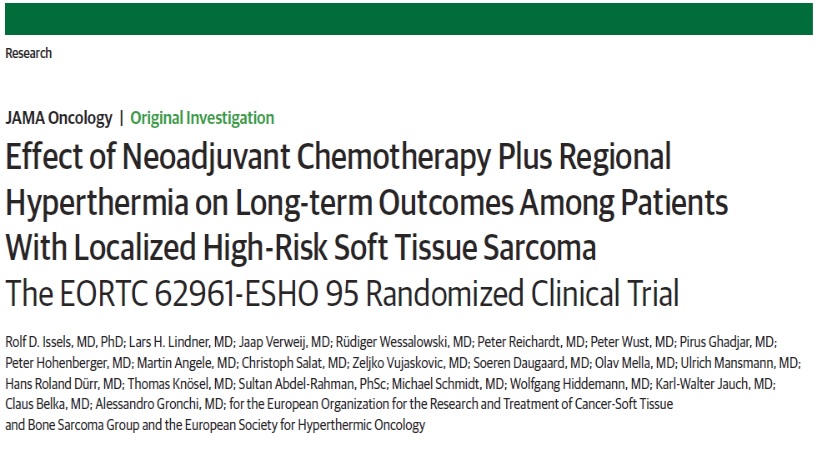Długofalowe efekty chemioterapii neoadjuwantowej łączonej z hipertermią miejscową u pacjentów z mięsakami wysokiego ryzyka.
tytuł oryg.: Effect of Neoadjuvant Chemotherapy Plus Regional Hyperthermia on Long-term Outcomes Among Patients With Localized High-Risk Soft Tissue Sarcoma. The EORTC 62961-ESHO 95 Randomized Clinical Trial.
Wydawnictwo: Jama Oncology
Autor główny: Rolf D. Issels
Pozostali autorzy: Lars H. Lindner; Jaap Verweij; RüdigerWessalowski; Peter Reichardt; PeterWust; Pirus Ghadjar; Peter Hohenberger; Martin Angele; Christoph Salat; Zeljko Vujaskovic; Soeren Daugaard; Olav Mella; Ulrich Mansmann; Hans Roland Dürr; Thomas Knösel; Sultan Abdel-Rahman; Michael Schmidt; Wolfgang Hiddemann; Karl-Walter Jauch; Claus Belka; Alessandro Gronchi;
Data: 2018-02-15

DOI: 10.1001/jamaoncol.2017.4996
Język publikacji: angielski
Klasa publikacji: Badanie kliniczne
Rodzaj badania: Randomizowane, wieloośrodkowe
Liczba pacjentów: 341
Rodzaj HT: LRHT fale radiowe
Rodzaj HT opis: HT miejscowa, głęboka, 60 minut, temperatura od 40° C do 43° C
Aparatura: BSD-2000
Jednostka chorobowa: Nowotór tkanki miękkiej wysokiego ryzyka
Symbol Jednostki chorobowej: HR STS
Typ skojarzenia HT stosowany w badaniu: HT+CT
Rodzaj CT: NACT (doksorubicyna, etopozyd, ifosfamid)
Abstract. Importance: Patients with soft tissue sarcoma are at risk for local recurrence and distant metastases despite optimal local treatment. Preoperative anthracycline plus ifosfamide chemotherapy improves outcome in common histological subtypes.
Objective: To analyze whether the previously reported improvement in local progression-free survival by adding regional hyperthermia to neoadjuvant chemotherapy translates into improved survival.
Design, Setting, and Participants: Open-label, phase 3 randomized clinical trial to evaluate the efficacy and toxic effects of neoadjuvant chemotherapy plus regional hyperthermia. Adult patients (age ≥18 years) with localized soft tissue sarcoma (tumor ≥5 cm, French Federation Nationale des Centers de Lutte Contre le Cancer [FNCLCC] grade 2 or 3, deep) were accrued across 9 centers (6, Germany; 1, Norway; 1, Austria; 1, United States) from July 1997 to November 2006. Follow-up ended December 2014.
Interventions After stratification for tumor presentation and site, patients were randomly assigned to either neoadjuvant chemotherapy consisting of doxorubicin, ifosfamide, and etoposide alone, or combined with regional hyperthermia.
Main Outcomes and Measures The primary end point was local progression-free survival. Secondary end points included treatment safety and survival, with survival defined from date of randomization to death due to disease or treatment. Patients lost to follow-up were censored at the date of their last follow-up.
Results A total of 341 patients were randomized, and 329 (median [range] age, 51 [18-70] years; 147 women, 182 men) were eligible for the intention-to-treat analysis. By December 2014, 220 patients (67%; 95% CI, 62%-72%) had experienced disease relapse, and 188 (57%; 95% CI, 52%-62%) had died. Median follow-up was 11.3 years. Compared with neoadjuvant chemotherapy alone, adding regional hyperthermia improved local progression-free survival (hazard ratio [HR], 0.65; 95% CI, 0.49-0.86; P = .002). Patients randomized to chemotherapy plus hyperthermia had prolonged survival rates compared with those randomized to neoadjuvant chemotherapy alone (HR, 0.73; 95% CI, 0.54-0.98; P = .04) with 5-year survival of 62.7% (95% CI, 55.2%-70.1%) vs 51.3% (95% CI, 43.7%-59.0%), respectively, and 10-year survival of 52.6% (95% CI, 44.7%-60.6%) vs 42.7% (95% CI, 35.0%-50.4%).
Conclusions and Relevance Among patients with localized high-risk soft tissue sarcoma the addition of regional hyperthermia to neoadjuvant chemotherapy resulted in increased survival, as well as local progression-free survival. For patients who are candidates for neoadjuvant treatment, adding regional hyperthermia may be warranted.
Potrzebujesz więcej danych o artykule? Skontaktuj się z PTHO droga mailową.